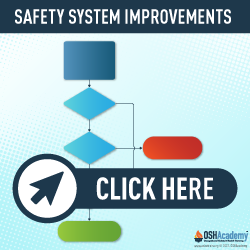Evaluating the Safety Management System
The negative effects of a flawed system are often due to inadequate resources, system design, and/or system performance.
If one or more of these three system components are flawed, the effect will be flawed conditions and behaviors. Often, management must decide if a flawed condition or behavior is the result of a flaw in the system or a policy violation which may require disciplining the violator.
Management must determine if adequate resources were available, if the system design was adequate, and if the system performance was adequate. If any of the three system components were inadequate, then the system is at fault and no discipline should be administered. If all three of the system components were clearly adequate, then discipline may be necessary.
If discipline is used despite an inadequate system, employees will feel as though they are being blamed without cause. This can lead to resentment and low morale. It is important to only discipline if the system has been shown to be adequate.
The flowchart to the right can be used as a guide when evaluating the safety management system. If any of the questions can be answered with a "No," then the system is inadequate and must be corrected. It is possible for more than one system component to be inadequate; therefore, each component should be evaluated and corrected as necessary.
Are any of the system components inadequate?
Bob, a maintenance worker with the company for 10 years, received a serious electrical shock while working on a conveyor belt motor. When Bob was asked why he did not use the company's established lockout/tagout procedures, he replied, "I thought about it, but the procedures were not current since the new equipment had been installed last year." Bob also indicated most of the other maintenance workers usually skipped the lockout/tagout procedures because they are constantly being told to "hurry up" and get the job finished.
- Resources: Did Bob have adequate resources to do the job?
- Yes. Bob did have the necessary resources to use the lockout/tagout procedures.
- System Design: Was the design of the lockout/tagout program adequate?
- No. The procedures were not current. They had not been updated since the installation of new equipment.
- System Performance: Were program policies and procedures being performed adequately?
- No. The policy to use lockout/tagout was not being used by other maintenance workers due to the procedural issues and the workers were not given the time necessary to follow proper safety procedures.
Results
In this scenario, discipline is not justified because two of the three criteria were not deemed adequate.
Knowledge Check Choose the best answer for the question.
4-6. What is a valid criterion to establish the justification for disciplinary action?
You forgot to answer the question!

